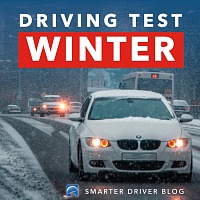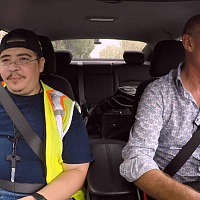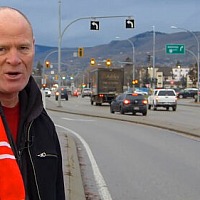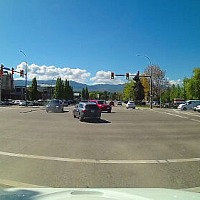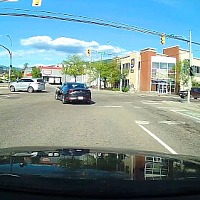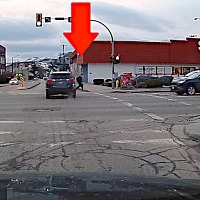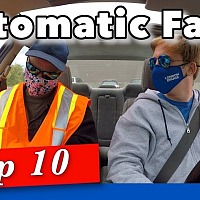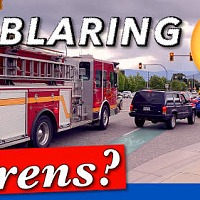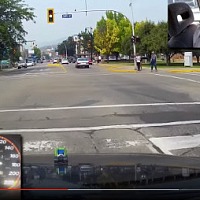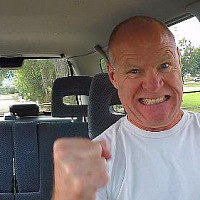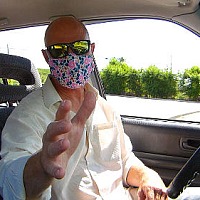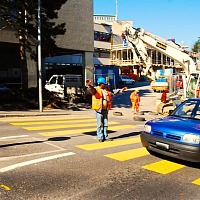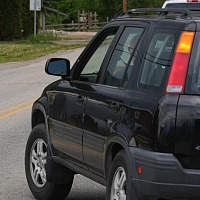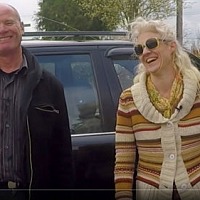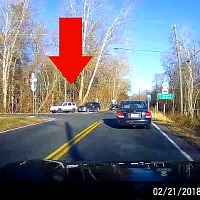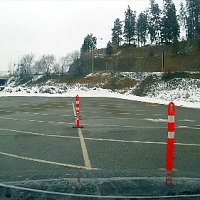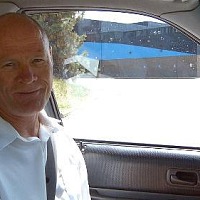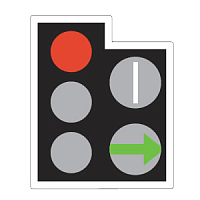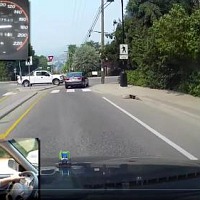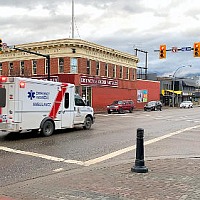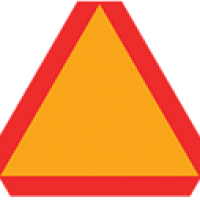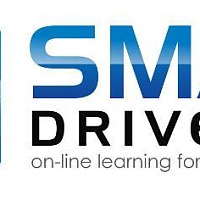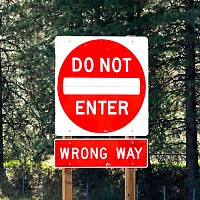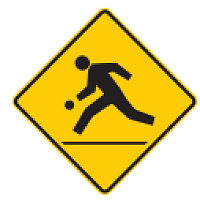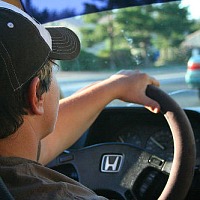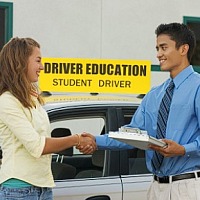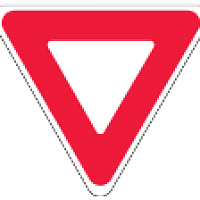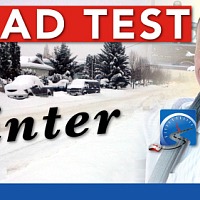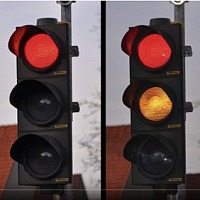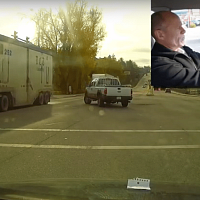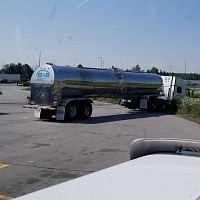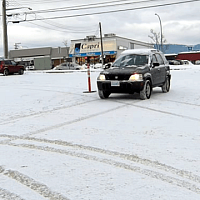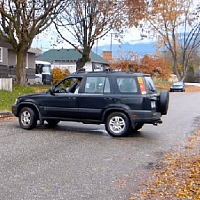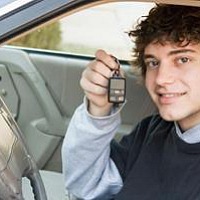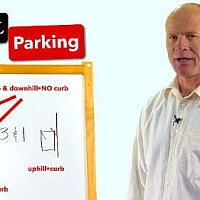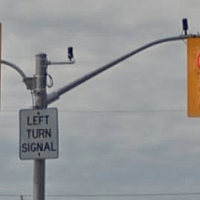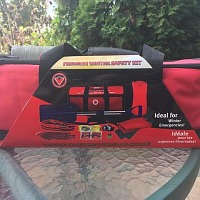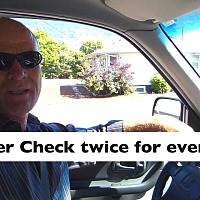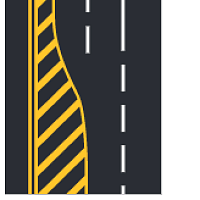Don't let space invaders cause you to crash!
|
Manage Space Around You To Pass Driver's License Test #SmartDriveTest #PassDriversTest #SpaceManagement Closed Caption |
Introduction
- Hi there, Smart Driver, Rick with Smart Drive Test talking to you today about space management for the purposes of passing a driver's test and for smart, defensive driving.
Stick around, we'll be right back with that information.
Space management for the purposes of passing a driver's test, is key.
Space management trumps speed management, in other words, you need to maintain your distance rather than applying the posted speed limit or whatever the flow of traffic is.
Stopping in Traffic
You see here, when I'm stopped in traffic, that I can see the tires of the vehicle in front of me making clear contact with the pavement.
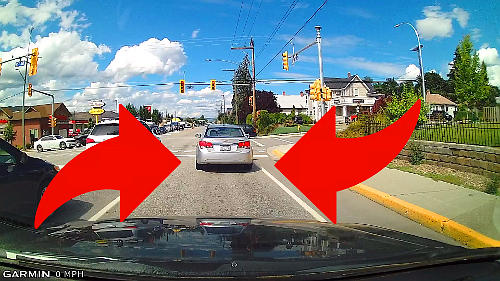 Stop in traffic so you can see the tires of the vehicle in front making clear contact with the pavement. This driving technique will reduce the risk of being rear-ended.
Stop in traffic so you can see the tires of the vehicle in front making clear contact with the pavement. This driving technique will reduce the risk of being rear-ended.
That is a critical skill to pass a driver's test.
It's also critical for keeping you safe when you're sitting here and parked.
If a car comes up behind, you're watching your center mirror where you're sitting here, and if they come up too fast, you can move up.
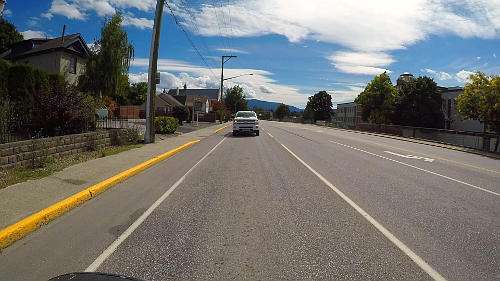 When sitting in traffic, watch the traffic approaching from behind to guard against being rear-ended.
When sitting in traffic, watch the traffic approaching from behind to guard against being rear-ended.
And oftentimes that's enough to get the vehicle behind you to get stopped before they rear-end you.
The other thing is, if that vehicle in front of you breaks down, you can drive around it without reversing in traffic, because the last thing you want to do, is reverse in traffic, it's both unpredictable and dangerous, so don't do it.
So if you can stop so you could see tires making clear contact with the payment and keep that habit, your whole driving career, you're going to be a lot safer.
Anticipating the Traffic Lights
Now you saw that vehicle in front of me raced up to the traffic light and came to a stop and then had to get going again, it's not efficient.
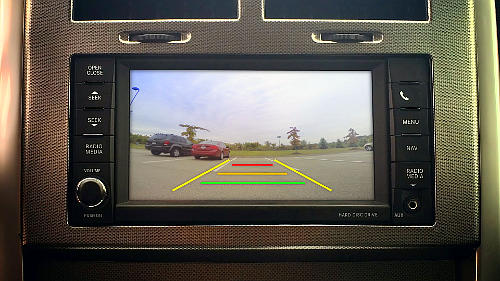 Even though you have a backup camera, still look out through the back when reversing. And do a 360° scan before you begin reversing to check the environment around your vehicle.
Even though you have a backup camera, still look out through the back when reversing. And do a 360° scan before you begin reversing to check the environment around your vehicle.
You see that I've backed off, I kept my space behind the vehicle and I didn't have to come to a stop at the traffic light, you can also see that he was, the vehicle in front of me was tailgating the vehicle in front, and, finally, the vehicle just changed lanes to prevent that vehicle from tailgating.
So I just hung back and because I'm hanging back and I've got a good buffer of space in front of me, I move up, I move back, I move up and I move back and I don't have to brake and my vehicle is not undergoing the wear and tear that you're going to do with aggressive braking and aggressive throttling.
 By maintaining space in front of your vehicle, you'll be a smarter defensive driver.
By maintaining space in front of your vehicle, you'll be a smarter defensive driver.
And when you stop at intersections, if you're the first one in the line, make sure that you stop behind the stop line because you can see that this stop line is farther back from the intersection, if I didn't stop back here, the cars coming around the corner are going to cut the corner off, potentially could strike the front of your vehicle, that's the reason that you have to stop behind the stop line.
How to Stop at Stop Lines
You stop so it just rolls under the front of the car.
If you stop back so you can see the stop line, you're going to be too far back from the intersection, and other cars are probably going to honk at you.
And, again, getting it up to speed as quickly as possible, for the purposes of the driver's test, when there isn't any other traffic around you.
But if there's other traffic around you, then your space management is going to come first and your speed management is going to come second.
So there's nobody in the roundabout, we just go straight through, we don't have to signal.
You can signal when you exit the roundabout, if practicable.
 Scan roundabouts in advance and if clear proceed without stopping. Signal as you would at a conventional intersection.
Scan roundabouts in advance and if clear proceed without stopping. Signal as you would at a conventional intersection.
Here, we're not going to block the intersection, we're going to let that guy go because it doesn't take any time out of your day to be nice.
The last point about stopping in traffic so you can see the tires of the vehicle in front of you making clear contact with the pavement is, is that if everybody did that in an ideal world, the traffic could all move off at the same time when the traffic light goes green and there would be less traffic congestion, but that's just not going to happen in any kind of world we live in.
You Can Alway Manage Space In Front of Your Vehicle!
So you can always manage the space in front of your vehicle.
You always have that two to three second following distance.
And I know that some drivers are going to say, "Oh, but somebody's going to cut you off, "they're going to take that space." Not very often.
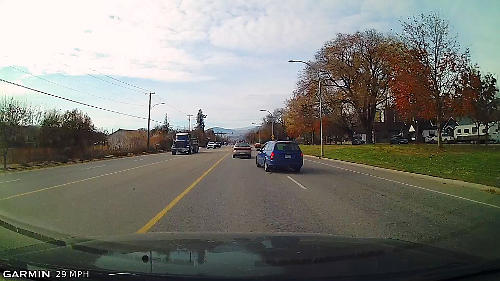 You can always control the space in front of your vehicle. Seldom do other driver's take the space. And if they do, slow slightly and regain your space in front.
You can always control the space in front of your vehicle. Seldom do other driver's take the space. And if they do, slow slightly and regain your space in front.
Every now and again they do that, but for the most part, they do not do that, they do not cut in front of you.
And as I said, it does happen, but because you're maintaining space, smart space around your vehicle, you're much safer.
Solid white lines, you can see those are near the intersection, do not change lanes.
Your Vehicle's Blind Areas
The other three sides of the vehicle, the two sides and the rear, the passenger side is your second biggest blind area, and to the rear of the vehicle is your biggest blind area.
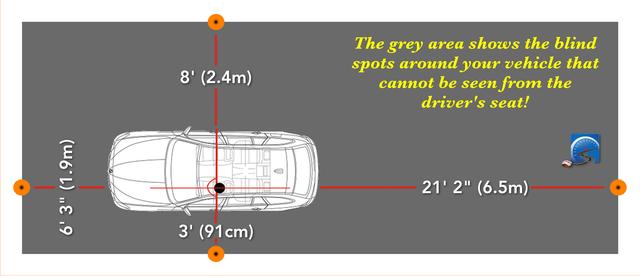 The biggest blind spots on your vehicle are on the passenger side and to the rear of the vehicle.
The biggest blind spots on your vehicle are on the passenger side and to the rear of the vehicle.
Near signal, shoulder check, and changing lanes over to the left, and I had my signal on, indicating to the vehicle behind me that I wish to move over, not that I was going to move over, and I'm going to turn left here and we get past the traffic island, shoulder check, and we move into the turning lane.
And, again, when we're in the turning lane, we stop so we can see the tires making clear contact with the pavement, I cannot stress that enough.
Turning Left And Right
And turning left, left lane to left lane, turning right, right lane to right lane.
As soon as we get around into the left lane, because you're going to be doing the posted speed limit for the purposes of practicing for your driver's test.
You're going to move back over to the right lane because the right lane is the slow lane and the left lane is the passing lane for those of us that live in North America.
And you can always control the space in front of your vehicle, and that is smart space.
 Other drivers are more likely to help you out if you ask via your signals.
Other drivers are more likely to help you out if you ask via your signals.
If you can control that space in front of your vehicle, it's always going to leave you an out, because in terms of defensive driving, it's faster to drive out of an emergency situation than it is to try and brake to avoid a crash in the event of an emergency situation.
Faster to Drive Out of An Emergency
- So you want smart space around your vehicle so that you can drive out of an emergency situation, whether it's to the left or to the right.
So the other thing that you don't want to do, is you don't want to pace somebody on a multi-lane road, you don't want somebody in this space beside you.
New cars are really good because they have blind spot detectors, either on the mirror or up here in the corner on the vehicle, and they are excellent for helping you out.
 Convex mirrors too will help to locate other road users in your blind areas, but continue to do shoulder checks as a backup and to stay safe.
Convex mirrors too will help to locate other road users in your blind areas, but continue to do shoulder checks as a backup and to stay safe.
And, of course, that does not mean that you stop doing shoulder checks if you have those on your vehicle, it's just another aid, because, remember, you always need to double-check, you always need a backup.
[Clip from the movie Serenity]
- We're fried, I've got no control!
- Where's the backup, where's the backup!
Technology is Great....But
- And when you do that, when you double-check and you are not relying on technology, you're not relying on your backup camera, you're not relying on your blind spot detectors to observe and see the space around your vehicle, you're going to be much safer.
 Some modern vehicles are fitted with blind spot detectors. These are helping, but continue to shoulder (head) check to stay safe.
Some modern vehicles are fitted with blind spot detectors. These are helping, but continue to shoulder (head) check to stay safe.
So the vehicle behind me has kept good space, I was watching my center mirror as the vehicle that was approaching, this lights turned, and we can proceed.
Left lane to left lane, around the corner, and the other woman is a way behind me, and so we move over to the right lane and maintain the speed, posted speed limit is 60 kilometers an hour or 40 miles an hour here and it's gone to 50.
And, again, there's no point rushing up here because the traffic is backed up and stopped.
And I'm probably in the wrong lane because I'm behind the truck lane here, but, again, I stopped so I can see the tires making clear contact with the pavement.
That way, if I want to change lanes, or I want to move over, I can do that.
And I was a little bit concerned about that exit there that I was going to be blocking that, but the truck in front of me moved up far enough that I'm not blocking it now.
You want to try not to block those.
 If you can't move through an intersection, don't move into the intersection because you will block it and be at risk of a crash.
If you can't move through an intersection, don't move into the intersection because you will block it and be at risk of a crash.
When you're moving up here, you want to maintain that space so other people can get out.
You know, cause you know what I say, it doesn't take any time out of your day to be nice to other people, so you could let one vehicle out and then proceed.
Good Observation is Critical to Good Space Management
Okay, we're going to turn right here, shoulder checking, shoulder checking again.
And space management, the key to space management is good observation.
And then as soon as we get around the corner, there's no traffic here, so we want to try and get up to the posted speed limit as quickly as possible.
If you have your driver's license, then you want to drive the flow of traffic.
 When other drivers are pushy and rude, it's more important to have space around your vehicle to protect yourself.
When other drivers are pushy and rude, it's more important to have space around your vehicle to protect yourself.
Speed Limit Inside the City
Okay, so I'm doing 50 kilometers an hour or 30 miles an hour for those of you in the States.
And of course I got a Jeep coming up here on the left.
I want to change lanes so I wait for the Jeep to go past and then I climb in behind the Jeep.
Because there's going to be people who are going to do that, you're going to put your signal on to move over and they're just going to be, you know, rammin' up there, going 4,000 miles an hour.
You know, not that a Jeep can do 4,000 miles an hour, I know that's not possible.
 Not all drivers will give you space. Even if you ask via your signal. So be ready to abort the manoeuvre.
Not all drivers will give you space. Even if you ask via your signal. So be ready to abort the manoeuvre.
We just stay back here, a good space behind them.
Again, always maintaining so we can see the tires making clear contact with the pavement.
We never get closer than that when we're in the line of traffic and the line of traffic is going slow, we always want to maintain that smart space around our vehicle.
Potholes...Always Potholes
All right, and you can see it was really bumpy there, I kind of moved over to the left of the lane to try and avoid some of that bumps and lumps and potholes and whatnot.
Okay, it's going to two-lane here, we're going to move over to the right, signal to the right.
And, again, we're maintaining our posted speed limit of 50 kilometers an hour or 30 miles an hour as according to the speed signs here.
That's the maximum speed in the city unless otherwise posted, 30 miles an hour or 50 kilometers an hour.
In New York City, the speed limit inside the city is 25mph unless otherwise posted - those New Yorkers like to be different!!
On highways, it's 80 kilometers an hour or 50 miles an hour.
 Be sure to stop before the stop line, otherwise you could be a risk of a collision by left-turning traffic in the intersection.
Be sure to stop before the stop line, otherwise you could be a risk of a collision by left-turning traffic in the intersection.
And we're going downhill here, and for those who're on driver's test to maintain your posted speed limit, again, you may have to brake a little bit to maintain 50 kilometers an hour or 30 miles an hour.
That gives you some techniques and skills about space management to pass both the driver's test and to stay safe when you're driving and be a defensive driver.
For another video, click here, to subscribe, click here.
And, remember, pick the best answer, not necessarily the right answer.
Have a great day, bye now.
 A unhappy woman driver smoking a cigarette and driving her PT Cruiser.
A unhappy woman driver smoking a cigarette and driving her PT Cruiser.
Blooper
Oh, she's smoking a cigarette, that's probably why she's not very happy.
This woman beside me is looking very unhappy.



